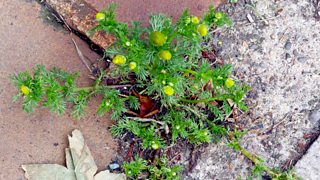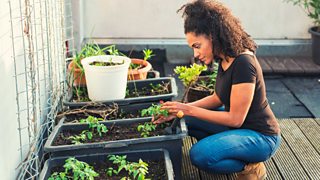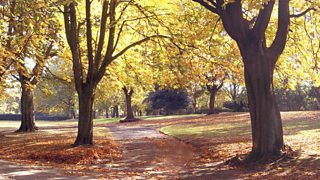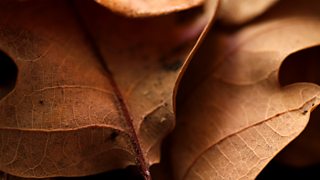Are weeds more important than we realise?
Weeds are a gardener’s nightmare. Often considered an eyesore, at the first sight of one sprouting we’re quick to douse it in weed killer and hastily pull out the roots. They find their way into our gardens, driveways and pavements, but could weeds be much more important than we realise?
In Open Country, Helen Marks follows writer and broadcaster Jane Perrone on a pavement safari in search of weeds and plants tucked into the cracks of our urban areas. We also hear from botanists Sophie Leguil, Phil Gates and Plantlife’s Trevor Dines, who tell us why we should give these so-called ‘pesky’ weeds another chance.

Chalking it out
Jane Perrone, plant and gardening journalist, heads off around her home of Bedfordshire in pursuit of wild plants and flowers peeking through the cracks of our pavements with a bag of chalk in tow. She’s following in the footsteps of botanist, Sophie Leguil, to write names next to the weeds she finds in the hope that others walking by will notice the overlooked flora.
After stumbling across her favourite street plant, Pellitory-of-the-Wall, a food plant of the Red Admiral butterfly, she also spots some common Poppy and a Sow Thistle.
Making her first chalk marking, which she did of course seek permission from the council to do so, she is eager for others to share her enthusiasm: “Hopefully somebody will be curious enough to have a Google of that and find out what Pellitory-of-the-Wall is.”
-
![]()
Open Country: Green Pavements
They are often trodden underfoot, but the plants growing in our pavements are important and getting noticed.
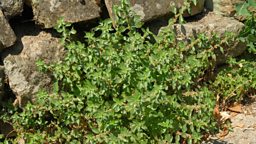
Vivre les sauvages
Urban botanist Sophie first did this in her home country of France and has continued chalking names in London.
Weeds have roles in ecology. They have a role for insects, urban biodiversity, they may be able to capture some pollution, they produce oxygen, they can help us understand our local environment better.
Paving the way since 1 January 2017, France banned pesticides in public spaces (apart from sports grounds and cemeteries) and now embraces its wildflowers and plants, even encouraging residents to sow seeds in the pavement cracks and walls.
Sophie was inspired to bring the same mentality to the UK and launched the project this year to help us embrace our urban biodiversity in walls, pavements and tree pits to ‘rewild’ the cities.
She explains “I wanted to convey the message that possibly those plants might be more than just weeds. They have roles in ecology, they have a role for insects, urban biodiversity, they may be able to capture some pollution, they produce oxygen, they can help us understand our local environment better.”
Getting around
Weeds grow in every corner of the country and in the most inconspicuous of places. Fascinated by how they made their way around, scientist Sir Edward Salisbury, who later became Director of the Royal Botanical Gardens at Kew, had an inkling that we were the culprits. At the end of Sunday Service in his hometown of Harpenden he collected the mud and dust around the pews that had fallen off the parishioners’ shoes, moistened his findings and let the seeds germinate to discover what weeds would grow. He wanted to see how many and which species were most often carried around on the soles of our shoes. Though, to this day, it’s still a mystery exactly how a plant seed travels from a countryside field to the pavement of Leicester Square station in London.
Weeds are hardy, quick flowering plants that are able to tolerate hostile environments which is why we find so many in the cracks of our pavements and walls. Some weeds even have taproots which wind all the way through the paving slabs to the depths of the soil underneath where they’ll find water and bring nutrients to the surface.
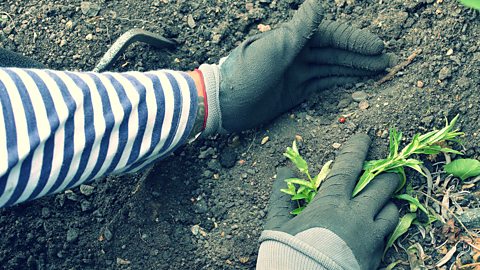
Sort out your garden weeds with a water cannon
Sybil Ruscoe hears about a new technique of weed management in your garden.
Botanist Phil Gates exlpains “they often complete their lifecycle quickly, so they’ll germinate in a mild winter, grow through the spring and flower very quickly, set and shed lots of seeds that can get down into those cracks in the pavement.”
Weeds are hardy, quick flowering plants that are able to tolerate hostile environments which is why we find so many in the cracks of our pavements and walls.
With the hustle and bustle of our cities there’s plenty of soles and vehicles moving seeds around, spreading wild flora.
The hundreds, or even thousands, of seeds in a single flower head certainty helps: one flower head of Lamb’s Quarters holds 75,000 seeds! There’s also ample choice of habitats a weed can take root in urban areas such as river banks, parks, gravel driveways, roof gardens and brick walls.
The heat trapped in concrete, brick and stone also creates a unique urban environment that lets less common plants like Passion flower and Oxford Ragwort thrive.
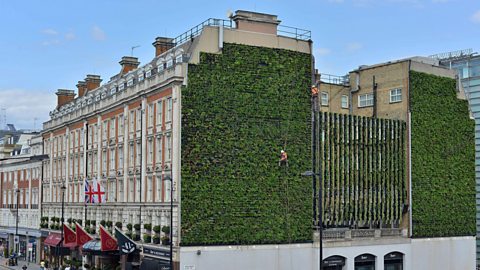
The growth of living walls and what makes them flourish
What's to be gained by covering buildings with thousands of plants?
The unsung hero?
The humble weed is also nature’s own fertiliser and will tell you a lot about your soil. Weeds including Dandelions and Plantain provide minerals and nutrients like potassium and calcium which help lacklustre soil that’s perhaps seen better days.
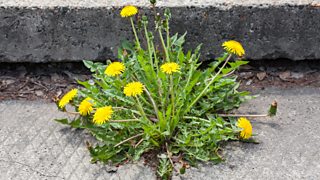
These clever little plants also indicate what the soil is missing - White Clover appears if there’s a nitrogen deficit. Though we’re usually eager to remove weed roots, they’re great at strengthening topsoil and weeds with deep roots pull up nutrients to the surface which will help other plants flourish. Even once they’ve died the leaves and rotting roots add organic matter and provide a route for air and rain to pass through, creating a more fertile soil. And if that wasn’t enough, they also attract handy insects like ladybirds, minute pirate bugs (these are basically plant pest control) and pollinators which are vital to local biodiversity.
Sophie explains weeds may even provide a much-needed boost to your mood if you’re trapped between the grey walls of a concrete jungle: “They have a role in potentially helping our mental health. Just seeing little bits of nature, it’s important to reveal that world. It’s sitting there beneath our feet and it’s just waiting to be discovered really.”
Green verges
It’s among these reasons that Trevor Dines, who works for plant conservation charity , thinks councils need to pay more attention to road verges. Plantlife’s research has found there are over 700 different species of wildflowers growing on our verges, accounting for 45% of our flora. He emphasises “these places are incredibly diverse, rich and incredibly important because things like Sulphur Clover, which is a specialist plant of clay in East Anglia, where most of the population are on road verges and without these verges they would’ve been driven to extinction.”
Plantlife is reaching out to councils to delay cutting the verges which will allow the wildflowers to set seed and germinate to ensure they return and bloom again. But, with councils preferring short and neat roadsides because of road safety and access reasons, getting them on board with wildflower verges is proving a challenge.
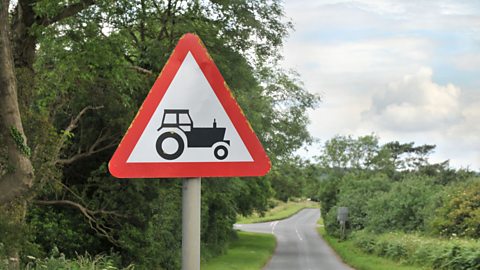
Roadside verges: to cut or not to cut?
Some people are concerned that the green road margins are getting out of control.
Though, some have made the change to cut mowing costs, improve biodiversity and adapt to public taste. Rotherham Borough Council has eight miles of wild verges and roundabouts, while Leicestershire County Council is taking requests for wildflower verges in certain locations.
There are over 700 different species of wildflowers growing on our verges, accounting for 45% of our flora.Plant conservation charity Plantlife
Something that more councils have been able to adopt is reducing or eliminating weed killer use altogether.
Hammersmith and Fulham Council decided to ban glyphosate weed killers and instead use foam and hot water treatments since in 2016.
Wild garden
If you fancy embracing your local weeds, go on your own pavement safari and try to name what you find - Sophie recommends the to help identify what you’re looking at. By simply going for a walk you’ll be moving the wild seeds along, contributing to the spread of our flora.
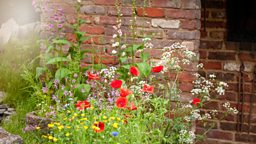
You could even create your own wildflower garden for a low maintenance colourful bloom that lasts. Packet mixes of wildflower seeds (best sown in autumn) are easily available to sprinkle in a flower bed or to liven up a patch of patio. If you want something just as hardy with a little more fragrance, herbs like lavender, thyme and chamomile will enjoy gravel or concrete surroundings and add a touch of nature to a garden path.
There’s also plenty of edible weeds you could experiment with. Dandelions have even been dubbed a superfood! Perhaps the next time you see some wild flora you’ll think twice about what it can do for your local area and maybe even see some beauty in it.
More from Radio 4
-
![]()
Open Country: Green Pavements
They are often trodden underfoot, but the plants growing in our pavements are important and getting noticed.
-
![]()
How you can save the environment through gardening
Abandon the lawn mower, let nature take control and transform your life with plants.
-
![]()
Six beautiful words to describe autumn
Other parts of the world have their own wonderful ways of referring to the season.
-
![]()
Can you match the autumn leaf to the tree?
As the leaves fall, who doesn't enjoy stepping on a satisfyingly crunchy leaf?
